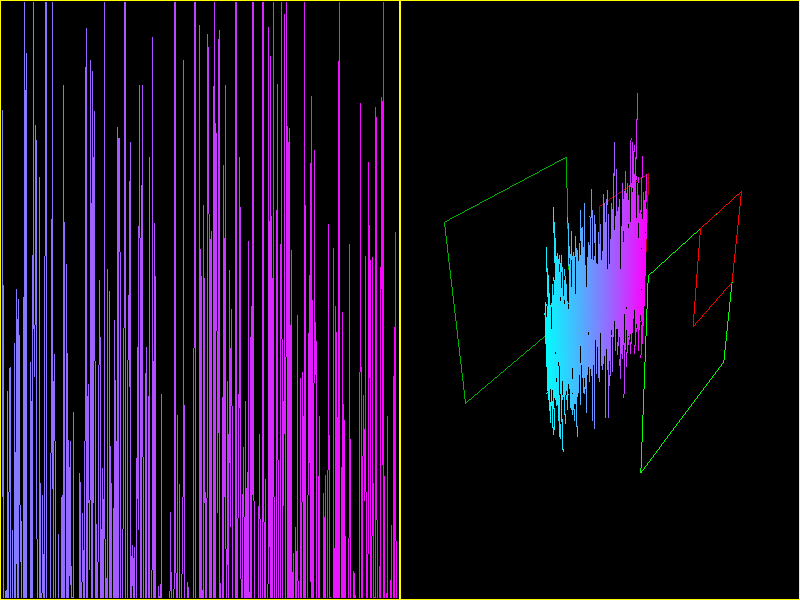Note
Go to the end to download the full example code.
ViewBox with Clipping Methods#
Demonstrate ViewBox using various clipping methods.

SubScene [NullTransform]
+--Widget [STTransform]
| +--Grid [STTransform]
| +--ViewBox: "vb1" [STTransform]
| +--SubScene: "vb1_Scene" [MatrixTransform]
| +--BaseCamera [NullTransform]
| +--PanZoomCamera [STTransform]
| +--Line: "line1" [NullTransform]
| +--Line: "unit box" [NullTransform]
| +--Line: "nd box" [NullTransform]
+--ViewBox: "vb2" [STTransform]
+--SubScene: "vb2_Scene" [ChainTransform]
+--BaseCamera [NullTransform]
+--TurntableCamera [MatrixTransform]
+--Line: "line1" [NullTransform]
+--Line: "unit box" [NullTransform]
+--Line: "nd box" [NullTransform]
+--Line: "unit box" [NullTransform]
+--Line: "nd box" [NullTransform]
import sys
import numpy as np
from vispy import app
from vispy import scene
# Create canvas
canvas = scene.SceneCanvas(size=(800, 600), show=True, keys='interactive')
grid = canvas.central_widget.add_grid()
# Create two ViewBoxes, place side-by-side
vb1 = grid.add_view(name='vb1', border_color='yellow')
# First ViewBox uses a 2D pan/zoom camera
vb1.camera = 'panzoom'
# Second ViewBox uses a 3D perspective camera
vb2 = grid.add_view(name='vb2', border_color='yellow')
vb2.parent = canvas.scene
vb2.camera = scene.TurntableCamera(elevation=30, azimuth=30, up='+y')
#
# Now add visuals to the viewboxes.
#
# First a plot line:
N = 1000
color = np.ones((N, 4), dtype=np.float32)
color[:, 0] = np.linspace(0, 1, N)
color[:, 1] = color[::-1, 0]
pos = np.empty((N, 2), np.float32)
pos[:, 0] = np.linspace(-1., 1., N)
pos[:, 1] = np.random.normal(0.0, 0.5, size=N)
pos[:20, 1] = -0.5 # So we can see which side is down
# make a single plot line and display in both viewboxes
line1 = scene.visuals.Line(pos=pos.copy(), color=color, method='gl',
antialias=False, name='line1', parent=vb1.scene)
line2 = scene.visuals.Line(pos=pos.copy(), color=color, method='gl',
antialias=False, name='line1', parent=vb2.scene)
# And some squares:
box = np.array([[0, 0, 0],
[0, 1, 0],
[1, 1, 0],
[1, 0, 0],
[0, 0, 0]], dtype=np.float32)
z = np.array([[0, 0, 1]], dtype=np.float32)
# First two boxes are added to both views
box1 = scene.visuals.Line(pos=box, color=(0.7, 0, 0, 1), method='gl',
name='unit box', parent=vb1.scene)
box2 = scene.visuals.Line(pos=box, color=(0.7, 0, 0, 1), method='gl',
name='unit box', parent=vb2.scene)
box2 = scene.visuals.Line(pos=(box * 2 - 1), color=(0, 0.7, 0, 1),
method='gl', name='nd box', parent=vb1.scene)
box3 = scene.visuals.Line(pos=(box * 2 - 1), color=(0, 0.7, 0, 1),
method='gl', name='nd box', parent=vb2.scene)
# These boxes are only added to the 3D view.
box3 = scene.visuals.Line(pos=box + z, color=(1, 0, 0, 1),
method='gl', name='unit box', parent=vb2.scene)
box5 = scene.visuals.Line(pos=((box + z) * 2 - 1), color=(0, 1, 0, 1),
method='gl', name='nd box', parent=vb2.scene)
if __name__ == '__main__' and sys.flags.interactive == 0:
print(canvas.scene.describe_tree(with_transform=True))
app.run()
Total running time of the script: (0 minutes 0.762 seconds)
